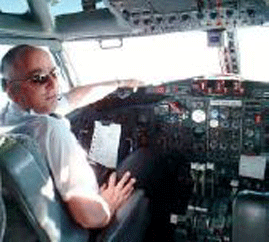Captain Cargo
Fashions For Freight Dogs

Captain Cargo grew up in Southern Africa, where, at
the age of nineteen, he started flying by accident. After ten years
spraying tsetse flies, locusts and other nasty insects, interspersed
with spells flying tourists and Hemingway wannabes around the Okavango
Delta and Kalahari Desert, he moved to the United Kingdom.
After obtaining a UK ATPL, he joined an airline that flies freight for
a major parcel delivery company. He has been doing it ever since, and
now flies a Boeing 757 freighter around Europe, mainly at night. Mail
to: CaptainCargo@aircargonews.com
I guess uniforms are essential, though I often think
the standard uniform of white shirt, tie, black jacket and trousers
is inappropriate for freight flying. Come winter, most of us ditch various
parts of the uniform and all sorts of jackets, scarves, woolly hats
etc. appear, with some of the more colorful characters looking more
like motorway workers with the whole ensemble topped off with a high-vis
vest.
Still, when you look at the uniform UPS pilots have to wear, I
suppose ours isn’t so bad. Except the hat. I mean, what a ridiculous
piece of attire. It would be more at home on the head of one of the
Village People than walking through an airport. I lost mine years ago.
There are probably only ten pilots in the company that wear one.
One company I worked for, a well-known Scottish airline, was quite
strict about the uniform. Hats were obligatory, and I had to polish
over the orange stitching on my Doctor Martin boots.
Some of our pilots and engineers have come up with novel labor-saving
combinations.
Why iron a shirt when you can wear a jumper over it? Just turn
down the heating in the flight deck. If the other crew members get cold,
tell them to put on a jumper.
By far the best, though, was one of our Captains who used to fly
a Bandeirante. Realizing that all the passengers ever saw of him was
his right hand, shoulder and arm, he only ironed the right hand side
of his shirts.
Now he’s flying freight, he doesn’t iron his shirts at all.
As winter drags on, I’m expecting the company to publish something
about dress code. It won’t get much response.
It’s just too cold in Scandinavia to insist we wear the standard
issue clothes.
We can only heat the flight deck on the ground with the apu running.
We stand around in the mornings waiting for taxis in the snow or
rain.
The passenger crews walk past us as they report for work in their
immaculate uniforms and shiny shoes and look down their noses at us,
their shoddy brethren flying ancient dirty machines while they press
buttons and stare down the hostess’s cleavage as she serves them breakfast.
Ah, little do they know. As they fly their six sectors a day on
the same route all week, waiting for their slots, I’m asleep, waiting
for darkness and the noise of three JT 8’s piercing the night, carrying
me off to some city I never expected to visit this week.
My dirty boots rest on the footrest in front of me, tie removed
hours ago, as I wonder if we’ve lost radio contact or if it is just
another quiet night.
Sleep well, my immaculate friends.
|



